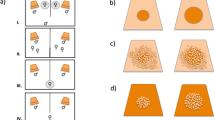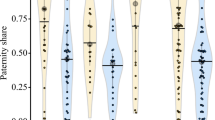Abstract
The pay-off of deserting and leaving a mate to care for the offspring alone is generally assumed to depend mainly on the availability of alternative mating partners and on the potential spawning rate of males and females. Eretmodus cyanostictus is a monogamous mouthbrooding cichlid in which the clutch is successively incubated first by the female and then by the male. It has been suggested that parents are constrained to monogamy due to low remating probabilities for both sexes. We tested this hypothesis by varying the sex ratio experimentally. Mate desertion by either sex was not significantly higher when additional potential mates were present (males: 8.3%, females: 0%) than when there were no other same-sex conspecifics present (males: 0%, females: 0%). Males lost their mate to a male intruder during their incubation in 26.7% of cases. Pair members were more active and showed more aggression when same-sex conspecifics were present. Behavioural differences between treatments were strongest during the incubation period of a given sex. If no desertion takes place, sexual conflict may be expressed also on a second level, the amount of parental care each parent provides. Indeed, males took the offspring later when additional females were present, although male incubation time did not differ between treatments. A hitherto undescribed display behaviour of females was clear evidence of a conflict about the timing of shift of young. In conclusion, offering alternative mating opportunities did not strongly favour mate desertion in E. cyanostictus. It rather revealed a conflict between mates about when to shift the young.






Similar content being viewed by others
References
Balshine-Earn S, Earn DJD (1998) On the evolutionary pathway of parental care in mouth-brooding cichlid fish. Proc R Soc Lond B 265:2217–2222
Barlow GW (1984) Patterns of monogamy among teleost fishes. Arch Fischereiwiss 35:75–123
Barta Z, Houston AI, McNamara JM, Székely T (2002) Sexual conflict about parental care: The role of reserves. Am Nat 159:687–705
Clutton-Brock TH (1991) The evolution of parental care. Princeton University Press, Princeton
Emlen ST, Oring LW (1977) Ecology, sexual selection, and the evolution of mating systems. Science 197:215–232
Grafen A and Sibly R (1978) Model of mate desertion. Anim Behav 26:645–652
Gross MR, Sargent RC (1985) The evolution of male and female parental care in fishes. Am Zool 25:807–822
Grüter C, Taborsky B (2004) Mouthbrooding and biparental care: an unexpected combination, but male brood care pays. Anim Behav 68:1283–1289
Harding JA, Almany GR, Houck LD, Hixon MA (2003) Experimental analysis of monogamy in the Caribbean cleaner goby, Gobiosoma evelynae. Anim Behav 65:865–874
Keenleyside MHA (1983) Mate desertion in relation to adult sex ratio in the biparental cichlid fish Herotilapia multispinosa. Anim Behav 31:683–688
Keenleyside MHA (1985) Bigamy and mate choice in the biparental cichlid fish Cichlasoma nigrofasciatum. Behav Ecol Sociobiol 17:285–290
Keenleyside MHA (1991) Cichlid fishes—behaviour, ecology and evolution. Chapman & Hall, London
Kokita T (2002) The role of female behaviour in maintaining monogamy of a coral-reef filefish. Ethology 108:157–168
Kuwamura T (1986) Parental care and mating systems of cichlid fishes in lake Tanganyika: a preliminary field survey. J Ethol 4:129–146
Kuwamura T (1997) The evolution of parental care and mating systems among Tanganyikan cichlids. In: Kawanabe H, Hori M, Nagoshi N (eds) Fish communities in Lake Tanganiyka. Kyoto University Press, Kyoto, pp 57–86
Kuwamura T, Nagoshi M, Sato T (1989) Female-to-male shift of mouthbrooding in a cichlid fish, Tanganicodus irsacae, with notes on breeding habits of two related species in Lake Tanganyika. Environ Biol Fish 24:187–198
Lessells CM (1998) Sexual conflict in animals. In: Keller L (ed) Levels of selection. Princeton University Press, Princeton, pp 74–99
Magrath MJL, Elgar MA (1997) Paternal care declines with increased opportunity for extra-pair matings in fairy martins. Proc R Soc Lond B 264:1731–1736
Maynard Smith J (1977) Parental investment: a prospective analysis. Anim Behav 25:1–9
Morley JI (2000) Intraspecific competition and monogamy in the cichlid fish, Eretmodus cyanostictus. PhD Thesis, University of Cambridge
Morley JI, Balshine S (2002) Faithful fish: territory and mate defence favour monogamy in an african cichlid fish. Behav Ecol Sociobiol 52:326–331
Morley JI, Balshine S (2003) Reproductive biology of Eretmodus cyanostictus, a cichlid fish from Lake Tanganyika. Environ Biol Fish 66:169–179
Neat TB, Balshine-Earn S (1999) A field survey of the breeding habits of Eretmodus cyanostictus, a biparental mouthbrooding cichlid in lake Tanganyika. Environ Biol Fish 55:333–338
Oppenheimer JR (1970) Mouthbreeding in fishes. Anim Behav 18:493–503
Perrone M, Zaret TM (1979) Parental care patterns of fishes. Am Nat 113:351–361
Queller DC (1997) Why do females care more than males? Proc R Soc Lond B 264:1555–1557
Rahman N, Dunham DW, Govind CK (2003) Social monogamy in the big-clawed snapping shrimp, Alpheus heterochelis. Ethology 109:1–17
Reavis RH, Barlow GW (1998) Why is the coral-reef fish Valenciennea strigata (Gobiidae) monogamous? Behav Ecol Sociobiol 43:229–237
Rogers W (1987) Sex ratio, monogamy and breeding success in the Midas cichlid (Cichlasoma citrinellum). Behav Ecol Sociobiol 21:47–51
Royle NJ, Hartley IR, Parker GA (2002) Sexual conflict reduces offspring fitness in zebra finches. Nature 416:733–736
Slagsvold T, Lifjeld JT (1994) Polygyny in birds: the role of competition between females for male parental care. Am Nat 143:59–94
Székely T, Cuthill IC (2000) Trade-off between mating opportunities and parental care: brood desertion by female Kentish plovers. Proc R Soc Lond B 267:2087–2092
Taylor MI, Morley JI, Rico C, Balshine S (2003) Evidence for genetic monogamy and female-biased dispersal in the biparental mouthbrooding cichlid Eretmodus cyanostictus from Lake Tanganyika. Mol Ecol 12:3173–3177
Trivers RL (1972) Parental investment and sexual selection. In: Campbell B (ed) Sexual selection and the descent of man 1871–1971. Heinemann, London, pp 136–179
Wade MJ, Shuster SM (2002) The evolution of parental care in the context of sexual selection: a critical reassessment of parental investment theory. Am Nat 160:285–292
Wisenden BD (1994) Factors affecting mate desertion by males in free-ranging convict cichlids (Cichlasoma nigrofasciatum). Behav Ecol 5:439–447
Yamaoka K (1997) Trophic ecomorphology of tanganyikan cichlids. In: Kawanabe H, Hori M, Nagoshi N (ed) Fish communities in Lake Tanganiyka. Kyoto University Press, Kyoto, pp 25–56
Yanagisawa Y (1986) Parental care in a monogamous mouthbrooding cichlid Xenotilapia flavipinnis in lake Tanganyika. Jpn J Ichthyol 33:249–261
Acknowledgements
We thank Mark Abrahams, Tamas Székely, Michael Taborsky and one anonymous referee for helpful discussions and comments on an earlier draft of the manuscript, Dik Heg for help with the statistics, and Rolf Eggler and Peter Stettler for aquarium maintenance, and logistic and technical support. This study was partially financed by a grant to B.T. by the Austrian Science Fund (FWF P14327-B06). When we carried out our experiments, we adhered to the legal requirements of Switzerland (licence no. 44/02, Kantonales Veterinäramt Bern, Switzerland).
Author information
Authors and Affiliations
Corresponding author
Additional information
Communicated by M. Abrahams
Rights and permissions
About this article
Cite this article
Grüter, C., Taborsky, B. Sex ratio and the sexual conflict about brood care in a biparental mouthbrooder. Behav Ecol Sociobiol 58, 44–52 (2005). https://doi.org/10.1007/s00265-004-0900-8
Received:
Revised:
Accepted:
Published:
Issue Date:
DOI: https://doi.org/10.1007/s00265-004-0900-8




